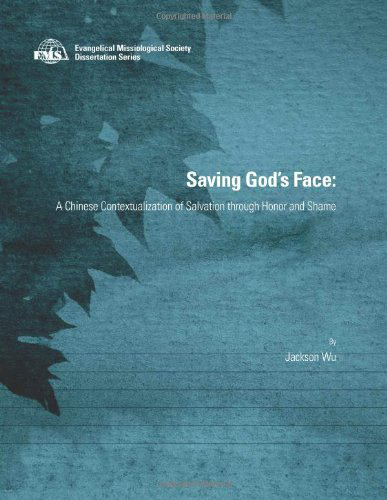Saving God’s Face: A Chinese Contextualization of Salvation Through Honor and Shame
A Book Review

“There is no such thing as theology; there is only contextualized theology.” (quoting Stephen Bevans, p.1)
“Imagine coming to the Bible with Eastern eyes.” (p.55)
“HS [honor and shame] are not peripheral categories in Scripture. Rather, they and related concepts are central.” (p.177)
The above quotes from Jackson Wu’s work nicely set the table for the full feast—a unique contextualization process demonstrated, and superbly applied to the Chinese context.
 Wu’s book, Saving God's Face, is in dissertation format and includes six chapters. Here is a summary:
Wu’s book, Saving God's Face, is in dissertation format and includes six chapters. Here is a summary:
I. Introduction
Helpfully introduces and summarizes each chapter.
II. Theological Contextualization in Practice
This chapter establishes the need for a model of contextualization that is not simply translation, communication, or application, but an act of interpretation, or an interpretive process. Wu exposes the common fallacy that threatens the contextualization process—to assume the gospel and presume that our own formulation of the gospel is the pure culture-free one. Wu offers here a model of contextualization that uses culture to interpret Scripture, allowing culture to lead the conversation in a dialogical process, but one which gives final primacy to Scripture. Among the rich wealth of theological motifs of Scripture, some will more readily resonate in one culture, some in another.
Due to its worldview themes of individualism and individual rights, Western theology has emphasized the legal, forensic, judicial biblical motifs for atonement (the penal substitution theory). The Chinese worldview themes of reputation (saving or losing “face”), group identity (collectivism) and proper relationships (hierarchy, harmony, roles) call for a theology that emphasizes honor and shame (“HS” hence in this article). Both the Western (law, guilt, penal substitution, justification) and the Eastern themes (preserving honor and removing shame, relational harmony) are in the biblical texts. However, the strong HS theme and many HS images are central in Scripture; the “glory” of God theme is the honor of God (Hebrew kavod is translated as both “glory” and “honor,” which are conceptual synonyms). Yet these themes are less visible to Western eyes and are underemphasized in Western theology.
Wu provides two figures that illustrate his model and map the contextualization process (p.53, 65).
III. Theologizing for Chinese Culture
This chapter describes seven Chinese cultural values, what needs to be addressed in a Chinese context, and what has been attempted toward a Chinese theology. Wu then describes six approaches to contextualization that have been tried for the Chinese context: Situational, Sino, Synchronistic, Scriptural, Systematic, and Soterian. The various approaches of writers he cites “return to the question of how one can be both Chinese and Christian” (p.145). Many turn to the Pauline material but reaffirm the Western emphasis on the legal motif and the individual. Wu asks, “How might cultural factors take the lead and alter our reading of Scripture to provide new but legitimate interpretations?” (p.147) He highlights the importance of metaphors and the use of narrative. “Not only does story have a way of challenging people more holistically within their context, but it guards against ‘proof-texting’ one’s assumptions and fosters greater respect for the entire canon” (p.147).
IV. Honor and Shame in Context
In this chapter Wu discusses definitions of HS, in contrast to guilt, in relation to morality, and in terms of “face” (reputation, standing, status, dignity) in Chinese culture. He claims, “The concept of shame permeates every aspect of Chinese life” (p.153), and that “Collectivism, honor and shame have an inherently public nature” (p.154).
He expounds on HS in Scripture and demonstrates that the theme is far more integral in the whole canon than most Western theology usually sees. Humans have dishonored God, and so shamed themselves. This condition needs reversing, rescue and reconciliation. Christ bore the shame.
He affirms Enoch Wan’s proposal as consistent with a Chinese view of HS. Summarizing Wan, Wu writes, “Glory (pre-fall), Shame (post-fall), and Glorification (post-fall). Chinese values of family, honor, and harmony should produce a gospel message that corrects the overemphasis on the forensic nature of the Gospel…” (p.185). Wu cites Roland Muller’s book Honor and Shame, which focuses on reconciliation as the primary expression for an HS gospel presentation appropriate for the highly relational collectivist cultures (p.188). He cites Bill Musk who actually explains what sin is, using HS language, briefly calling it a “violation of honor” (p.189).
V. A Soteriology of Honor and Shame
 The goal of this chapter is to find out how Chinese culture adds to an understanding of salvation. Applying Wu’s contextualization process allowing Chinese culture to lead the conversation, the HS themes of the collectivist culture draw out different facts and veracities that are truly in the Scriptures (this is not eisegesis) but that Western theology has not emphasized. The biblical exegesis by Wu gives primacy to HS themes. He notes, “HS need not be relegated to rhetorical theory and anthropology, as if they were distinct from mainstream exegetically-based theology,” and that “law is every bit as much as an anthropological, culturally laden category as HS. Exegesis cannot a priori privilege any metaphor, regardless of interpretive precedent or the preponderance of a theme in other extra-biblical documents” (p.195).
The goal of this chapter is to find out how Chinese culture adds to an understanding of salvation. Applying Wu’s contextualization process allowing Chinese culture to lead the conversation, the HS themes of the collectivist culture draw out different facts and veracities that are truly in the Scriptures (this is not eisegesis) but that Western theology has not emphasized. The biblical exegesis by Wu gives primacy to HS themes. He notes, “HS need not be relegated to rhetorical theory and anthropology, as if they were distinct from mainstream exegetically-based theology,” and that “law is every bit as much as an anthropological, culturally laden category as HS. Exegesis cannot a priori privilege any metaphor, regardless of interpretive precedent or the preponderance of a theme in other extra-biblical documents” (p.195).
Wu’s Chinese interpretations answer three basic questions. I will summarize his answers briefly after each question:
1. “What Does the Atonement Do for God?”
“If Christ did not die, God would lack honor. God is shameful.” (Recall that God made promises to Abraham that he would bless all nations through his offspring (cf.Gen. 12:3; Gal. 3:8); therefore, if Christ does not die, then the nations will not be saved. In that case, God would lie and lose face.) “The cross saves God’s ‘face.’” “Jesus died for God” (p.197). As he was about to go to the cross, Jesus said to God, “Father, glorify (honor) Your Name!” (John 12:28-29), showing that God honored Himself by Jesus dying on the cross. As the prayer in Psalm 79:9 says,
“Help us, Oh God of our salvation for the glory of your name: deliver us, and atone for our sins for your name’s sake!” (emphasis Wu’s) (p.198).
2. What Did Jesus Accomplish for People (Objectively)?
Christ’s atonement centrally concerns the honor of God and the shame of man. It is the story of how God has acted to bring reconciliation between humans and Himself, expunging human shame while saving God’s “face.”
God’s honor (glory) inheres in, or is a consequence, or accompaniment of his intrinsic worth. God’s honor (worth) was devalued, impugned, ignored, obscured by human sin. God’s dishonored (profaned, desecrated) worth must be compensated for, set right. God’s worth is so great, that the only object or entity that could satisfy, vindicate, and validate God’s vitiated honor is Christ’s death.
So Christ’s atoning death restores people who are in union with Christ into right relationship with God. This is possible due to the corporate solidarity and identification principles conveyed in Pauline thought in I Corinthians 15: 22-23, 45 and Romans 5:12-21. Fallen humans are “in Adam.” But those who are “in Christ… belong to Christ,” “are righteous, and share his glory” (honor) (p.202). Though Western individualists find this hard to comprehend, this is in accord with the collectivist thinking in the Chinese worldview and the Hebraic worldview, where the community is more fundamental than the individual. The HS themes helpfully connect the Chinese context with the ancient biblical cultures. There is much overlap in the worldview themes of the two cultures.
Jesus’ sacrifice was a “compensatory payment” (Morris, p.208).
The cross preserves God’s honor (saves God’s “face”), and takes away human shame. Jesus’ substitutionary atonement is not only a penal substitution (the traditional Protestant view), but is also an honor substitution. Jesus said to the Father, “The glory (honor) that you have given to me, I have given to them, that they may be one even as we are one.” (John 17:22)
3. What Did Jesus Accomplish for People (Subjectively)?
The promises of the new covenant (which are communal as well as individual) enacted in Christ’s death and resurrection provide forgiveness and regenerative power by the Holy Spirit to actually change human hearts and renovate the human self in this life. Wu states, “Reconciliation with God requires a subjective change of heart in his people, necessarily causing them to honor God with their lives.” (p.216)
VI. Conclusion
In this chapter Wu discusses the implications of his work for contextualization and Chinese theology. Wu interprets Scripture herein through “Chinese eyes,” using HS concepts. He does not reduce contextualization to simply translating or applying a Western theological version of the Gospel into a Chinese concept. He concludes, “theologian-missionaries can utilize an HS perspective to develop a soteriology that is faithful to the biblical narrative.” (p.295)
He recommends that “missionary strategy should reflect the dialogical and integrated nature of contextualization.” (p.296) The church must reevaluate how it trains missionaries. The contextualization process he proposes places a premium on recruiting and retaining long-term workers. It takes much time and deep identification with another culture to see through its eyes and for the cross-cultural workers to question their own theology and worldview assumptions.
He closes with some provocative questions, one of which we who are Western individualists should seriously consider—“what other doctrines [other than soteriology, my comment] might be amended if we change our fundamental point of reference from the individual to the collective? How might HS affect ecclesiology and church leadership?” (p.299).
Having summarized the book, I will now offer some concluding comments according to the order of logic in Wu’s work and as signaled by the three opening quotes in this review.
Contextualization: Getting it Right
Wu states “There is no such thing as ‘theology’; there is only contextualized theology.” (quoting S. Bevans, p.1) Naïve is the assumption that one can go directly from Scripture to application. We all bring our cultural assumptions to the text. So, Wu argues, when we prematurely assume the gospel, we are “begging the question,” assuming the conclusion within the premise of an argument. When we assume we have the pure formulation of the gospel (as though it is culture-free), the methods of contextualization we tend to use are mere communication and/or application. We have settled on the meaning of the gospel, so we assume we now must simply communicate it accurately—decode and encode, translate the concepts and encode them into another language. Or we move directly to application. But the problem is that we are applying an already-contextualized (to us, by us) formulation into that other culture.
Traditionally, contextualizers have started with Scripture (what does the Bible say?). Next they analyze the receptor culture (what is this culture’s worldview and felt needs?). Then they encode the gospel (as they have formulated it) into the receptor culture’s language and to the worldview themes and culture forms as they have perceived them. It is essentially a one-way communication process, from source to receptor.
For example, consider the contrast of a Western (legal-judicial, individualistic) formulation of the gospel to the Chinese or Eastern worldview (honor/shame, relational harmony). Say we simply took the ideas of the modern “Four Spiritual Laws” and translated them into Mandarin, seeking to get our audience to apply them directly to the guilt of law-breaking we assume the Chinese to be conscious of. The problem would be that the “Four Spiritual Laws” formulate the gospel in the Western favored themes. This is a Western worldview in Mandarin language. These themes do not speak to the hearts of Chinese like the HS themes do. Thus, Wu skillfully shows how “it is quite possible that our evangelistic bridges lead listeners to cross the cultural divide in the wrong direction” (p.24).Converts are expected to accept the missionary’s own cultural thought forms. “If the contextualizers limit the relationship between Scripture and culture to a few select points, their ‘bridges’ may in fact act as a wedge between the gospel and the local culture” (p.24-25).Contextualization is then superficial.
Wu’s model reverses this traditional order. His method of contextualization avoids assuming the gospel and “begging the question.” Contextualization is foremost interpretation. Wu claims “culture must lead the conversation” (p.46). He makes a medical analogy: a physician starts by looking at a person’s body, not by looking at a medical textbook; the body is analogous to culture, and the anatomy textbook is analogous to Scripture (p.56). So contextualizers start by looking at the culture. We must use culture to interpret the Bible. There is a saying, “We see the Bible not as it is, but as we are.” You start with understanding the receptor cultural context deeply, their ways of thinking, the questions they bring to the Bible due to their community’s narrative and the categories by which they read Scripture. So the culture sees in Scripture firstly what has meaning to it and its people. But the process is two-way, dialogical. Culture and theology are in constant conversation. In the end, those in the receptor culture interpret the Bible through their “eyes,” not having a foreign cultural version applied to them. Scripture conveys a diversity of gospel articulations, many motifs, themes, metaphors and images. Scriptural truth reaches culture with its embedded worldview themes and values. People will perceive in the Bible first what is most relevant to them in their socio-cultural existential condition.
Wu holds to the full inspiration and authority of the Bible. This is not liberalism or relativism. He states, “Finally, the ultimate question is never, ‘What does the culture want?’ Instead it is ‘What does the Bible say?’ Scripture has primacy” (p.56). In fact Wu has a very high view of the Bible––high enough to see that the Bible is so rich in meaning and supra-cultural in message that it can be interpreted by any society, and they will find God’s truth speaking to them.
This method of dialogical interpretive contextualization has great potential for use in any other cross––cultural context.
For Chinese Eyes Only?
 Chinese eyes see “face,” relational harmony and hierarchy, and are oriented toward group identity and thus, honor and shame. Westerners need to realize that the majority of the world has more collectivist societies—Africa, the Middle East, nearly all of Asia, and Latin America. It is largely only the Western and Northern European societies that are individualistic. These majority world cultures that emphasize HS will find in the Bible truths and themes that speak to their concerns; the themes of HS are prevalent in the Bible. It is the story of God’s glory (honor).
Chinese eyes see “face,” relational harmony and hierarchy, and are oriented toward group identity and thus, honor and shame. Westerners need to realize that the majority of the world has more collectivist societies—Africa, the Middle East, nearly all of Asia, and Latin America. It is largely only the Western and Northern European societies that are individualistic. These majority world cultures that emphasize HS will find in the Bible truths and themes that speak to their concerns; the themes of HS are prevalent in the Bible. It is the story of God’s glory (honor).
China and much of the Eastern world values reputation, respect for rank and status (saving or losing “face”), group identity (collectivism), and proper relationships (hierarchy, harmony, roles). Thus, “coming to the Bible with Chinese eyes,” one tends to pick up the HS themes that are there.
However, as Wu observes, “HS is a human category, not merely an ‘Eastern way of thinking’” (p.299). Westerners use different terms than “face” and the cultural expressions are different. Think of the European custom practiced until the last century of dueling to get satisfaction for impugned honor (We meet at dawn. Pistols or swords?). Humankind is homo honorificus. It is the case that some cultures more highly emphasize HS than others, but all have it. We would do well in the West to tap more deeply into this theological motif in Scripture.
Honor and Shame: Foundational in the Bible
Western theology is theology that is contextualized to Western cultures. In the individualistic societies of the West, people are oriented toward individual identity, individual merit, individual rights and freedom, individual salvation. Thus Western theology tends to emphasize the guilt and law themes in Scripture. Western theology uses predominantly the legal motif and legal-forensic language in discussing sin, atonement and salvation, especially since Luther and Calvin (John Calvin was a trained lawyer). Group identity or corporate solidarity plays a small role in Western systematic theology.
Wu notes that some Western theologians have recognized the motif of God’s glory as important in the Bible. But few Western theologians have developed the implications of HS as they influence the whole of Scripture. The The glory of God is a major theme throughout the Bible. “All have sinned and come short of the glory (honor) of God” (Rom 3:23) is a central diagnosis of the human condition, calling for salvation. Humans have dishonored God and themselves and this condition needs redemption. Yet, Western theology tends to treat “HS as primarily a social-science issue, not a theological problem on the same level as law” (p.7). There is so much more in Scripture about HS than most Western eyes have seen. Though the legal/forensic motif is biblical, the Bible consistently demonstrates a predominance of the Honor/Shame motif. Wu claims, “HS is foundational to the entire biblical narrative” (p.7).
Where from Here? Possibilities and Story
Wu focuses on contextualization for the formulation of doctrine from an HS perspective, specifically soteriology. Since the majority world is HS in cultural orientation, missiologists need to think beyond doctrine to more effective communication strategy with these cultures. In chapter 3, Wu asks “How might cultural factors take the lead and alter our reading of Scripture to provide new but legitimate interpretations?” (p.147). He highlights the importance of metaphors and the use of narrative. “Not only does story have a way of challenging people more holistically within their context, but it guards against ‘proof-texting’ one’s assumptions and fosters greater respect for the entire canon” (p.147).
I would have liked to see Wu develop this notion of story more. Yet perhaps it will be left to others to explore how story and oral strategies of communication will be most effectively used in HS cultures. Maintaining, losing and saving “face” expresses values stemming from one’s worldview; therefore, the use of story is critical to engaging HS culture. Stories address HS themes as people identify with the honor or shame they see in the stories’ characters; they are therefore very relevant to their HS worldview. Scripture is largely in the narrative genre (about 75%), and Jesus used stories as his primary way of teaching. The majority world is HS in worldview. This seems like a perfect storm convergence for major developments in oral strategies and Bible storytelling across the world.
There is a saying, “Story invites you into the room, but does not tell you where to sit.” Not telling people where to sit can save a lot of face. The stories can do their work of transformation from within, giving people space enough to change while saving face.









comments